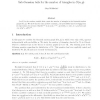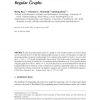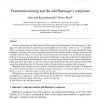617 search results - page 26 / 124 » On the Chromatic Number of Random Graphs |
NETWORKS
2010
13 years 8 months ago
2010
Let G = (V, E, Q) be a undirected graph, where V is the set of vertices, E is the set of edges, and Q = {Q1, . . . , Qq} is a partition of V into q subsets. We refer to Q1, . . . ...
CPC
2011
13 years 5 months ago
2011
Let X be the random variable that counts the number of triangles in the binomial random graph G(n, p). We show that for some positive constant c, the probability that X deviates f...
RSA
2002
13 years 9 months ago
2002
: The decycling number (G) of a graph G is the smallest number of vertices which can be removed from G so that the resultant graph contains no cycles. In this paper, we study the d...
EJC
2008
13 years 10 months ago
2008
Gerards and Seymour (see [T.R. Jensen, B. Toft, Graph Coloring Problems, Wiley-Interscience, 1995], page 115) conjectured that if a graph has no odd complete minor of order p, the...
DAM
2002
13 years 10 months ago
2002
A graph is said to be uniquely list colorable, if it admits a list assignment which induces a unique list coloring. We study uniquely list colorable graphs with a restriction on t...



